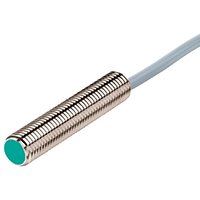Pilot Hole Position Verification in Metal Forming
Inductive Proximity Sensors Prevent Incorrectly Stamped Parts Due to Improper Material Feed

The Application
Evenly spaced, pre-punched pilot holes ensure that the metal strips are properly fed and aligned in the die. If a pilot hole is not positioned properly, inductive proximity sensors safeguard the forming process by stopping the press before the downstroke reaches a critical point.
The Goal
Pilot holes must be precisely aligned to guarantee that the stamped parts are formed correctly. Fast sensor response times and high accuracy are necessary to avoid unwanted quality issues associated with incorrectly stamped parts.
The Solution

NBB2-8GM30-E3 inductive proximity sensor
Inductive proximity sensors such as the NBB2-8GM30-E3 monitor a metal strip’s progression through a die by detecting pilot holes. Embedded in the die, the sensors ensure that the part is correctly positioned at each step of the forming process. The sensor logic is often “normally-closed” and provides a positive signal to the controller to initiate bends, cuts or punches when the hole is detected. Note—direct hole detection can be tricky as the sensing field is conical. If the fed strip has loose vertical tolerances, the sensor’s detection point will vary slightly. See Fig. 1.

Fig. 1
An alternative to the direct detection of pilot holes is the monitoring of spring-loaded, notched pilot pins located in the upper die. See Fig. 2.

Fig. 2
When the feed is short or long, the pilot pin hits the sheet metal on the downstroke and is compressed upward. By detecting the transition from notch to metal, the inductive sensor stops the press before a misstamp occurs. Again, a “normally-closed” switching output is used—only in the event of a fault does the sensor interrupt the process and stop the press. An additional advantage of the “normally-closed” switching is the indication of the sensor power loss. If the sensor supply is unknowingly interrupted, there is no risk of the feed process continuing unmonitored. Severed or loose connections will automatically shut down the press in the same way as when a misfeed is detected.
Technical Features
- Extended operating temperature range -40 ... +85 °C
- Increased operating distance: 2 mm flush
- Operating voltage: 5 ... 30 V
- Output type: PNP
- Reverse polarity protected
- Switching frequency: 0 ... 6000 Hz
The Benefits
Using an inductive proximity sensor to verify the position of pilot holes in metal stamping applications prevents incorrectly stamped parts and reduces unplanned downtime.
At a Glance
- Inductive sensors monitor a metal strip’s progression through a die
- Sensors ensure correct part position at each step of the forming process
- "Normally-closed" sensor logic provides a positive signal to the controller to initiate the specified process










 +46 303 246070
+46 303 246070